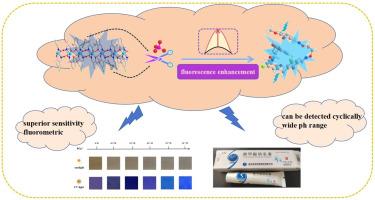salamo-Cu(II)聚合物中用于磷酸盐检测的拆卸激活荧光开关:从药物分析到环境监测
IF 4.7
2区 化学
Q2 CHEMISTRY, PHYSICAL
引用次数: 0
摘要
水体环境中过量的正磷酸盐(PO43−)是富营养化的主要原因,促进藻华,导致腐烂时氧气耗尽,导致缺氧和生态系统退化。为了解决这一挑战,我们设计了一种新的1D铜基配位聚合物(Cu-CP)荧光探针,由Cu2+和双萨拉莫配体(H4L)自组装而成。该探针在365 nm照射下对PO43 -表现出明显的荧光开启响应,具有超高灵敏度(LOD = 2.09 μM)、广泛的pH稳定性(4-11)和对竞争物种的优异选择性。HR-MS/XPS研究揭示了分解诱导的传感机制,即PO43−触发高荧光H4L配体的释放。探头可再生至少三个周期,性能一致。时间分辨荧光寿命测量进一步证实了感应途径。便携式测试条集成了基于智能手机的荧光读数,可以进行现场半定量检测,该系统已成功应用于环境水和药物样品。然而,目前在纯水介质中的实际应用受到Cu-CP溶解度的限制。未来的工作将致力于通过结构修饰或载体固定化来增强亲水性,以扩大其应用范围。本文章由计算机程序翻译,如有差异,请以英文原文为准。

Disassembly-activated fluorescence switching in salamo-Cu(II) polymer for phosphate detection: From pharmaceutical analysis to environmental monitoring
Excessive orthophosphate (PO43−) in aquatic environments is a primary cause of eutrophication, promoting algal blooms that lead to oxygen depletion upon decay, resulting in hypoxia and ecosystem degradation. To tackle this challenge, we designed a new 1D copper-based coordination polymer (Cu-CP) fluorescent probe, self-assembled from Cu2+ and a bis-Salamo-ligand (H4L). This probe exhibits a pronounced fluorescence turn-on response toward PO43− upon 365 nm irradiation, demonstrating ultrahigh sensitivity (LOD = 2.09 μM), broad pH stability (4-11), and excellent selectivity against competing species. HR-MS/XPS studies reveal a disassembly-induced sensing mechanism, whereby PO43− triggers the release of highly fluorescent H4L ligand. The probe can be regenerable for at least three cycles with consistent performance. Time-resolved fluorescence lifetime measurements further corroborate the sensing pathway. Portable test strips integrated with smartphone-based fluorescence readout enable on-site, semiquantitative detection, and the system has been successfully applied to environmental water and pharmaceutical samples. However, the practical application in pure aqueous media is currently constrained by the limited solubility of Cu-CP. Future efforts will aim to enhance hydrophilicity through structural modification or carrier immobilization to broaden its utility.
求助全文
通过发布文献求助,成功后即可免费获取论文全文。
去求助
来源期刊

Journal of Molecular Structure
化学-物理化学
CiteScore
7.10
自引率
15.80%
发文量
2384
审稿时长
45 days
期刊介绍:
The Journal of Molecular Structure is dedicated to the publication of full-length articles and review papers, providing important new structural information on all types of chemical species including:
• Stable and unstable molecules in all types of environments (vapour, molecular beam, liquid, solution, liquid crystal, solid state, matrix-isolated, surface-absorbed etc.)
• Chemical intermediates
• Molecules in excited states
• Biological molecules
• Polymers.
The methods used may include any combination of spectroscopic and non-spectroscopic techniques, for example:
• Infrared spectroscopy (mid, far, near)
• Raman spectroscopy and non-linear Raman methods (CARS, etc.)
• Electronic absorption spectroscopy
• Optical rotatory dispersion and circular dichroism
• Fluorescence and phosphorescence techniques
• Electron spectroscopies (PES, XPS), EXAFS, etc.
• Microwave spectroscopy
• Electron diffraction
• NMR and ESR spectroscopies
• Mössbauer spectroscopy
• X-ray crystallography
• Charge Density Analyses
• Computational Studies (supplementing experimental methods)
We encourage publications combining theoretical and experimental approaches. The structural insights gained by the studies should be correlated with the properties, activity and/ or reactivity of the molecule under investigation and the relevance of this molecule and its implications should be discussed.
 求助内容:
求助内容: 应助结果提醒方式:
应助结果提醒方式:


